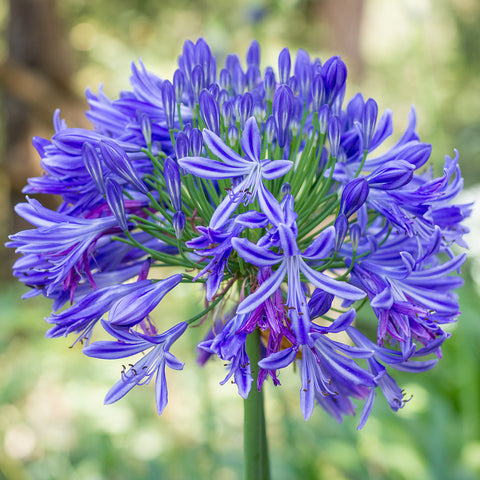Agapanthus Propagation: Tips for Expanding Your Plant Collection
Agapanthus Propagation: Tips for Expanding Your Plant Collection
Blog Article
Understanding the Art of Agapanthus Care: Necessary Steps for Healthy Growth and Vivid Blooms
In the realm of gardening, the growing of agapanthus stands as a fulfilling endeavor for those that look for to support these elegant flowering plants. With their striking flowers and stylish foliage, agapanthus has actually caught the interest of garden enthusiasts worldwide. However, accomplishing ideal growth and vivid blossoms needs a nuanced strategy that incorporates various necessary actions. From choosing the right variety to mastering trimming methods, the journey in the direction of growing prospering agapanthus plants is diverse and holds the key to unlocking the complete potential of these botanical treasures.

Picking the Right Agapanthus Selection

When selecting the appropriate Agapanthus variety for your garden, consider elements such as climate viability, blossom shade, and development routine. Agapanthus, generally referred to as Lily of the Nile or African lily, can be found in a range of colors ranging from shades of purple and blue to white. Select a flower shade that complements your existing garden combination to produce a harmonious landscape. In addition, think about the climate in your area to ensure the Agapanthus range you choose can prosper in your details conditions. Some ranges are more forgiving of chilly temperatures, while others favor warmer environments. Recognizing the development routine of different Agapanthus selections is crucial for appropriate positioning within your yard. Some varieties have a clumping growth practice, ideal for containers or boundaries, while others have an even more dispersing nature, suitable for ground cover or mass growings. By meticulously evaluating these factors, you can select the perfect Agapanthus range to enhance the appeal of your garden.
Suitable Planting Problems
Considering the optimum environmental demands is vital for successful Agapanthus cultivation. Agapanthus prospers in well-draining soil with a somewhat acidic to neutral pH level. When planting, select a location that receives complete sunlight to partial color. In hotter climates, offering some mid-day shade can protect against scorching of the leaves. Agapanthus plants are delicate to cold temperature levels and should be secured from frost throughout winter season.
To ensure healthy development and vivid blooms, plant Agapanthus bulbs at a deepness of about 2-4 inches and area them 8-12 inches apart. Mulching around the base of the plants assists preserve dampness and suppresses weed development.
Watering and Feeding Tips
Preserving correct dampness degrees and supplying crucial nutrients are essential aspects in the care routine for Agapanthus plants. When it comes to sprinkling Agapanthus, it is vital to strike a balance. These plants like regularly damp dirt but are prone to root rot if overwatered.
Fertilizing Agapanthus is necessary for promoting healthy and balanced growth and respected blooms. Use a balanced plant food, such as a 10-10-10 formula, in the very early spring as brand-new growth arises. By following these watering and fertilizing suggestions, you can ensure your Agapanthus plants prosper and produce dynamic, lasting blossoms.
Pruning Strategies for Agapanthus
Pruning Agapanthus plants at the ideal times and with appropriate strategies is critical for preserving their wellness and promoting ideal growth and blooming. The excellent time to trim Agapanthus remains in late winter or early spring prior to brand-new growth arises. Beginning by eliminating any yellowing or dead leaves near the base of the plant. Cut them as close to the ground as possible without harming the arising shoots.
Deadheading spent flowers can additionally redirect the plant's energy right into generating even more blooms instead than establishing seeds. If you want to collect seeds for propagation, leave some flowers to mature and dry on the plant.
Bear in mind to make use of tidy, sharp tools to make precise cuts and minimize the risk of introducing diseases. Agapanthus. Normal trimming will aid keep your Agapanthus looking neat and healthy and balanced while making sure an abundant display of lovely flowers
Dealing With Usual Bugs and Conditions
After making certain correct trimming strategies for Agapanthus, it is important to resolve usual parasites and illness that can influence the health and wellness and vigor of these plants. One typical parasite that affects Agapanthus is the Agapanthus gall midget.
In addition, Agapanthus plants can suffer from origin rot if they are grown in poorly draining dirt. By being cautious and taking punctual activity versus conditions and insects, you can assist your Agapanthus plants thrive and produce vibrant blossoms. Agapanthus.

Verdict
To conclude, grasping the art of browse around this site agapanthus treatment involves picking the right range, supplying perfect planting problems, proper watering and feeding, suitable pruning strategies, and attending to usual insects and diseases. By complying with these essential actions, you can make certain healthy growth and lively blossoms for your agapanthus plants. Bear in mind to frequently monitor and maintain your plants to promote their overall health and durability.
To make sure healthy growth and lively blooms, plant Agapanthus light bulbs at a deepness of concerning 2-4 inches and space them 8-12 inches apart. By adhering to these watering and feeding suggestions, you can ensure your Agapanthus plants prosper and produce vivid, lasting blossoms.
One common pest that impacts Agapanthus is the Agapanthus gall midge. In addition, Agapanthus plants can suffer from root rot if they More hints are planted in poorly draining soil. By following these necessary steps, you can view website ensure healthy and balanced growth and vibrant blooms for your agapanthus plants.
Report this page